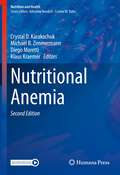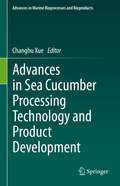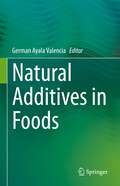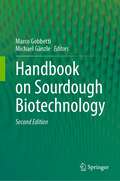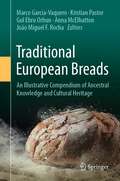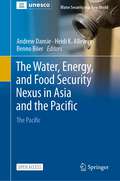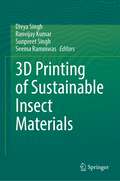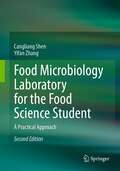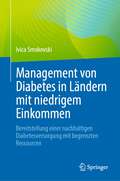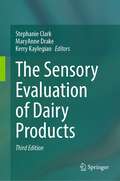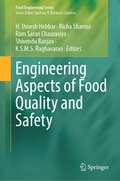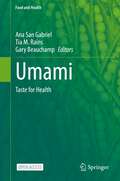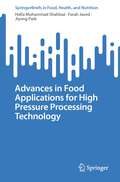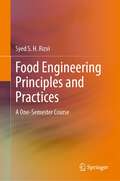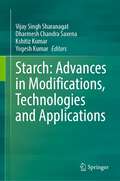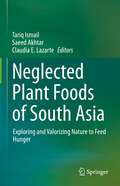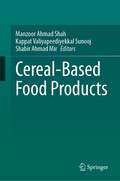- Table View
- List View
Sustainable Food Innovation (Sustainable Development Goals Series)
by Luca ServentiThis text offers a holistic approach to the two topics of the highest interest in the current and future food industry: sustainability and nutrition. The current knowledge is narrow and specific to individual topics focusing on either one nutrient or one discipline. Food is part of a wide circle of disciplines: nutrition, technology, sensory, environmental aspects, psychology, economy, culture and society. In the recent years, the sales of innovative foods such as meatless burgers, allergen-free products and personalized nutrition have skyrocketed. Sustainable Food Innovation presents the big picture on each nutrient: industrial and natural sources (ingredients, food products), consumer acceptability (price, sensory quality) and nutritional properties (quantity and quality) with each chapter focusing on a specific essential nutrient. Further chapters illustrate the role of other elements of interest such as bioactive. In addition, experimental data is added to enrich the book. Online discussions on current food trends are analyzed and presented to the reader in the effort to understand consumers’ psychology. This will be the first publication to combine literature review and research data and the first to offer a comprehensive discussion on sustainable food innovation. The ultimate goal is to educate consumers and experts, providing technical and socioeconomic knowledge in a multidisciplinary context. Ultimately, informed technologists will develop healthier, sustainable food products and informed consumers will make informed decisions on nutrition and food choices.
Biodegradable and Environmental Applications of Bionanocomposites (Advanced Structured Materials #177)
by Visakh P. M.This book provides cutting-edge, up-to-date research findings on the use of bionanocomposites in biodegradable and environmental applications, while also detailing how to achieve bionanocomposites preparation, characteristics, and significant enhancements in physical, chemical, mechanical, thermal properties and applications. This book on biodegradable and environmental properties of bionanocomposites provides a comprehensive and updated review of major innovations in the field of polymer-based bionanocomposites for biodegradable and environmental applications. It covers properties and applications, including the synthesis of polymer-based bionanocomposites from different sources biomaterials-based composites and tactics on the efficacy and major challenges associated with successful scale-up fabrication on bionanocomposites.It is an essential reference for future research in bionanocomposites as topics such as sustainable, biodegradable, and environmental methods for highly innovative and applied materials are current topics of importance. The book covers a wide range of research on bionanocomposite and their biodegradable and environmental applications. Updates on the most relevant polymer-based bionanocomposite and their prodigious potential in the fields of biodegradable and the environment are presented. Leading researchers from industry, academy, government, and private research institutions across the globe contribute to this book. Scientists, engineers, and students with interest in the most important advancements in the field of bionanocomposites involving high-performance bionanocomposites will benefit from this book which is highly application-oriented.
Failure to Thrive and Malnutrition: A Practical, Evidence-Based Clinical Guide
by Joyee Goswami VachaniFailure to Thrive (FTT) is a multifactorial illness requiring the systematic application of evidence in conjunction with a multidisciplinary team-based approach. Evidence suggests most cases of FTT can be diagnosed using key elements of the patient history and physical examination including appropriate growth assessment, and that laboratory testing is usually unhelpful in determining an etiology. Despite this, there is wide variation in the definition, evaluation, treatment, costs, and outcomes of FTT patients, with subsequent burdens on the healthcare system. A suggested approach to the differential diagnosis and management of FTT is to review calories – inadequate caloric intake, excessive calorie losses, and/or increased caloric intake (i.e. increased metabolic demand) – while acknowledging the available resources along the continuum of patient care. Implementing evidence-based practice for FTT provides improvement opportunities for providers and potentially has significant impact on the healthcare system. This book is designed to present a practical and concise handbook on the diagnosis and management of failure to thrive (FTT)/ malnutrition for quick reference by trainees and practitioners by using case examples and available evidence in the current literature. This book is divided into 7 chapters in a logical progression of defining, diagnosing, and managing FTT with cases in each chapter to further illustrate evidence-based care.
Nutritional Anemia (Nutrition and Health)
by Klaus Kraemer Crystal D. Karakochuk Michael B. Zimmermann Diego MorettiUnderstanding the causes of anemia is critical to inform appropriate strategies to prevent and treat anemia, particularly to reduce the risk of anemia and the burden of disease. The strength of this book lies in its cross-disciplinary nature. This publication summarizes the current state of evidence on the multifactorial causes of anemia, with a specific focus on nutritional anemia. The chapter authors are leading experts in nutrition and global health. The introductory chapters provide an overview of the global burden of anemia prevalence, the economic implications and functional consequences of anemia, and the significance of these factors to guide policy and programs. Subsequent chapters provide current evidence on iron and other micronutrient metabolism and homeostasis in regards to anemia, the multifactorial contributors to anemia (e.g. infection and genetics), and the interactions between nutrients that may contribute to anemia. The summarizing chapters detail program and policy approaches to treat, prevent and reduce anemia in the global context. Nutritional Anemia is a comprehensive resource for those involved in global health and nutrition policy, strategy, programming, or research, and serves as a guide for how government, NGO, and international agencies can effectively treat, prevent and reduce anemia globally.
Pediatric Neurogastroenterology: Gastrointestinal Motility Disorders and Disorders of Gut Brain Interaction in Children
by Nikhil Thapar Christophe Faure Carlo Di LorenzoThis third edition brings together the latest in research and clinical practice of the expanding field of pediatric neurogastroenterology. In addition to a comprehensive review of the current state of the art, many chapters have been significant revised and updated, covering the latest discoveries of the delicate and detailed mechanisms of the neuroenteric system as well as relationships of the latter with microbiota and metabolites produced by resident intestinal bacteria. The book also covers rapidly-changing techniques to assess clinical problems, along with international diagnostic criteria and recommendations and guidelines for clinical management. The content is supported by ample figures, photographs and selected video segments.Remaining the gold standard text in this up-and-coming field, Pediatric Neurogastroenterology 3e is dedicated to reporting the most accurate and recent knowledge available. Written by international experts in the field, the book is a comprehensive and up-to-date theoretical review and practical guide to pediatric gastrointestinal motility and functional disorders to pediatricians, pediatric gastroenterologists and all professionals involved in the treatment of children with such disorders.
Advances in Sea Cucumber Processing Technology and Product Development (Advances in Marine Bioprocesses and Bioproducts)
by Changhu XueSea cucumbers belong to the Phylum Echinodermata. There are more than 900 recorded species of sea cucumber of which more than 40 are edible. As a food source, sea cucumbers are rich in protein, low in fat, rich in collagen, sulfated polysaccharides, phospholipids, glycolipids, saponins and other functional components. Therefore, sea cucumbers have important nutritional and medicinal value. Growing awareness of these health benefits has promoted growth in marine aquaculture and processing technologies for the development of sea cucumber products for many applications.Novel perspectives of nutritional functions and processing technologies of sea cucumbers are defined in this book. The chemical structure and nutritional function of sea cucumbers are systematically reviewed. These include the functional/nutritional components, the endogenous enzymatic properties related to processing efficiency and product quality, and the efficient preparation technology of functional components. The traditional processing technology is presented as the background context to highlight the advances in new processing technologies including low-temperature cooking technology based on controllable negative pressure system, heat pump-hot-blast air combined drying technology, microwave sterilization of instant sea cucumber, collagen stabilization technology. The book finishes with the authentication of sea cucumber types and origin, quality standards, product quality control systems and food safety requirements.
Natural Additives in Foods
by German Ayala ValenciaAdditives have been used in the food sector for centuries, aiming to maintain or improve food quality in terms of freshness, appearance, texture and taste. Most food additives are synthetic chemical compounds classified as antioxidants, antimicrobials, colorants and sweeteners. In the last decades, several synthetic food additives have been correlated with adverse reactions in humans, which has caused the safety of synthetic food additives to be reviewed and discussed by international organizations. At the same time, there is increasing consumer demand for more natural and environmentally friendly food products and additives. Therefore, synthetic food additives have been replaced with natural food additives. Although the use of natural additives is a hot topic in food science, to date no book has systematically reviewed the application of natural additives in food products. Natural additives in foods presents an exhaustive analysis of the most recent advances in the application of natural additives in the food sector. Covering natural antioxidants, antimicrobials, colorants and sweeteners, this text also focuses on unconventional sources of natural additives, valorization and toxicological aspects, consumer attitudes and regulatory aspects. The main applications of natural antioxidants are fully covered, including polyphenols, ascorbic acid, carotenoids, tocopherols and proteins. Natural antimicrobial applications from polyphenols and essential oils to poly-L-Lysine are analyzed, as are natural colorants like anthocyanins, annatto, betalains and paprika. The encapsulation, trapping, and adsorption of natural additives are studied, and consumer perceptions and preferences are major focuses. Researchers will find up-to-date regulatory specifics for the United States and European Union.For any researcher in need of an expansive single source containing all relevant and updated information for the use of natural additives in foods, this book is a much needed addition to the field.
Image Based Computing for Food and Health Analytics: IBCFHA
by Rajeev Tiwari Deepika Koundal Shuchi UpadhyayIncrease in consumer awareness of nutritional habits has placed automatic food analysis in the spotlight in recent years. However, food-logging is cumbersome and requires sufficient knowledge of the food item consumed. Additionally, keeping track of every meal can become a tedious task. Accurately documenting dietary caloric intake is crucial to manage weight loss, but also presents challenges because most of the current methods for dietary assessment must rely on memory to recall foods eaten. Food understanding from digital media has become a challenge with important applications in many different domains. Substantial research has demonstrated that digital imaging accurately estimates dietary intake in many environments and it has many advantages over other methods. However, how to derive the food information effectively and efficiently remains a challenging and open research problem. The provided recommendations could be based on calorie counting, healthy food and specific nutritional composition. In addition, if we also consider a system able to log the food consumed by every individual along time, it could provide health-related recommendations in the long-term. Computer Vision specialists have developed new methods for automatic food intake monitoring and food logging. Fourth Industrial Revolution [4.0 IR] technologies such as deep learning and computer vision robotics are key for sustainable food understanding. The need for AI based technologies that allow tracking of physical activities and nutrition habits are rapidly increasing and automatic analysis of food images plays an important role. Computer vision and image processing offers truly impressive advances to various applications like food analytics and healthcare analytics and can aid patients in keeping track of their calorie count easily by automating the calorie counting process. It can inform the user about the number of calories, proteins, carbohydrates, and other nutrients provided by each meal. The information is provided in real-time and thus proves to be an efficient method of nutrition tracking and can be shared with the dietician over the internet, reducing healthcare costs. This is possible by a system made up of, IoT sensors, Cloud-Fog based servers and mobile applications. These systems can generate data or images which can be analyzed using machine learning algorithms. Image Based Computing for Food and Health Analytics covers the current status of food image analysis and presents computer vision and image processing based solutions to enhance and improve the accuracy of current measurements of dietary intake. Many solutions are presented to improve the accuracy of assessment by analyzing health images, data and food industry based images captured by mobile devices. Key technique innovations based on Artificial Intelligence and deep learning-based food image recognition algorithms are also discussed. This book examines the usage of 4.0 industrial revolution technologies such as computer vision and artificial intelligence in the field of healthcare and food industry, providing a comprehensive understanding of computer vision and intelligence methodologies which tackles the main challenges of food and health processing. Additionally, the text focuses on the employing sustainable 4 IR technologies through which consumers can attain the necessary diet and nutrients and can actively monitor their health. In focusing specifically on the food industry and healthcare analytics, it serves as a single source for multidisciplinary information involving AI and vision techniques in the food and health sector. Current advances such as Industry 4.0 and Fog-Cloud based solutions are covered in full, offering readers a fully rounded view of these rapidly advancing health and food analysis systems.
Handbook on Sourdough Biotechnology
by Marco Gobbetti Michael GänzleBread and leavened bakery products have been essential to human nourishment for millennia. Traditionally, bread production has relied on the use of sourdough as a leavening agent and to impart a characteristic quality to baked goods. In recent years, improved understanding of the biodiversity and microbial ecology of sourdough microbiota, the discovery of new species, the improved management and monitoring of its meta-community and the commercialization of innovative products have vastly expanded the potential of sourdough fermentation for making baked goods. For example, raw materials such as cereals, pseudo-cereals, ancient grains, and gluten-free substrates, as well as a large number of baked good varieties (e.g., typical and industrial breads, sweet baked goods, gluten-free products) may benefit from advances in sourdough fermentation. In addition, biotechnological tools and culture properties have been discovered to improve both the shelf life and the sensory and textural qualities of baked goods, as well as their nutritional and health-promoting properties.Now in its second edition, the Handbook on Sourdough Biotechnology remains the only book dedicated completely to sourdough biotechnology with the contribution of the most experienced researchers from the field. It reviews the history of sourdough and the potential of sourdough fermentation in the production of bread and baked goods. A thorough discussion of the various processing steps includes the chemical properties of the raw matter, the taxonomy, diversity, and metabolic properties of starter yeasts and lactic acid bacteria, and the effects of sourdough fermentation on the shelf life and the sensory, textural, nutritional, and health-promoting properties of baked goods.
Traditional European Breads: An Illustrative Compendium of Ancestral Knowledge and Cultural Heritage
by Marco Garcia-Vaquero Kristian Pastor Gul Ebru Orhun Anna McElhatton João Miguel F. RochaThis text comprehensively covers the rituals, traditions and receipts of ancestral processes of bread making from multiple countries, including the scientific and technological character of the science of bread making and sourdough biotechnology. Individual chapters cover the scientific aspects of bread making in different cultures and traditions as well as the technological phenomena occurring during the bread making process, utilizing the full network of SOURDOMICS from the COST initiative.Pictures and illustrations are used to explain the science behind bread making processes and the cultural, historical and traditional elements associated with bread making in multiple countries. Authored by bread making experts from the breadth of Europe, the process of bread fermentation in each country and region is covered in detail. The traditions surrounding bread making are simply the empirical know-how passed between generations, and this book's main purpose is to perpetuate these traditions and know-how.Provides a description of the culture of European peoples with respect to the technology of bread making and sourdough biotechnology;Explains the process of bread fermentation using simple language combined with scientific rigor;High quality pictures and illustrations enrich the scientific and cultural elements mentioned in each chapter.
The Water, Energy, and Food Security Nexus in Asia and the Pacific: The Pacific (Water Security in a New World)
by Andrew Dansie Heidi K. Alleway Benno BöerThis open access book considers the water, energy, food (WEF) nexus in the Pacific region. The region comprises seventeen sovereign countries and seven territories spread across the Pacific Ocean, a blue expanse that covers a fifth of the world’s surface area but contains only 0.5% of the population—or 44.5 million people. The uniqueness of the Pacific and the need for a Pasifika-led approach to sustainability across environmental, societal and economical spheres requires this blue continent to be considered in a separate volume under the ‘Water Security in a New World’ series.This Pacific volume is focussed on water, energy and food security in Pacific Island Countries and Territories (PICTs) and the challenges produced by the impacts of anthropogenic climate change and human population pressures. The diversity of culture, traditional knowledge and ways of life across the Pacific are united by similar geographies and opportunities to apply a ‘Pacific specific’ WEF nexus approach; a coordinated approach to manage water, energy and food that is centred on active decision making across the three sectors to increase the security of each. Importantly, a WEF nexus approach builds on national and international efforts to date in the Pacific which include Integrated Water Resource Management, Ridge to Reef, Source to Sea, UNESCO Biosphere Reserves, Integrated Coastal Zone Management and other similar approaches.In this book, contributions by authors from governments, regional bodies, multilateral agencies, and academia describe water security and its intersectionality with both the energy and food sectors, highlighting the significance of both land and marine food systems and connectivity between water and energy in a Pacific-focussed context. It is demonstrated that these systems cannot be separated from the challenges associated with healthy environments and functioning ecological services, transport, and waste that are unique to this vast archipelagic region. To achieve meaningful change, it is essential that solutions are cognizant of the world’s colonial past and the global inequalities that persist today. The path forward for water and food systems is one that is Pasifika-led and builds on traditional knowledge and local capacity. National energy demands must consider the future with solutions comprising both WEF-integrated approaches and new energy technologies to hasten the transition away from fossil fuels. Globally, major greenhouse gas emitters both past and present need to step up for the environmental and economic benefit of all by rapidly reducing greenhouse gas emissions and supporting Pasifika leadership on highly ambitious net zero goals.This book is a highly recommended source of information and inspiration for policy makers, decision makers, research communities and practitioners dealing with any aspect of water, energy, or food security in the Pacific.
3D Printing of Sustainable Insect Materials
by Divya Singh Ranvijay Kumar Sunpreet Singh Seema RamniwasThis book compiles a diverse and interdisciplinary range of scientific literature, laboratory developments, industrial implications and future prospects covering Entomophagy in 3D food printing to fight against hunger and nutritional deficiencies. Recent developments in Entomphagy in 3D printing of Drosophila based materials, and their nutritional, social, economic, scientific and environmental aspects. are comprehensively covered. Readers will also find shortcomings, guidelines, and industrial prospects for these materials, with emphasis on processing methods for the extraction of sustainable materials through 3D food printing. 3D Printing of Sustainable Insect Materials focuses on the methodology, technology and processing used for utilizing insects in 3D food printing applications, establishing technology-driven knowledge to fight against hunger. Chapters cover the principles for Entomophagy, insect processing methods, modern 3D food printing technologies, and the theoretical and practical aspects of Emtomophagy in 3D printing, with a special focus on future prospects and technologies. This ground-breaking book will serve knowledge to researchers and industry professionals across the food industry with broad coverage of emerging technologies, materials developed through Entomophagy, functional characterization and the technical details required to produce sustainable insect-based materials through 3D food printing.
Food Microbiology Laboratory for the Food Science Student: A Practical Approach
by Cangliang Shen Yifan ZhangThis book is designed to give students an understanding of the role of microorganisms in food processing and preservation; the relation of microorganisms to food spoilage, foodborne illness, and intoxication; general food processing and quality control; the role of microorganisms in health promotion; and federal food processing regulations. The listed laboratory exercises are aimed to provide a hands-on-opportunity for the student to practice and observe the principles of food microbiology. Students will be able to familiarize themselves with the techniques used to research, regulate, prevent, and control the microorganisms in food and understand the function of beneficial microorganism during food manufacturing process. The second edition add 5 new chapters including “Chapter 10 -Thermal inactivation of Escherichia coli O157:H7 in mechanically tenderized beef steaks and color measurements”, “Chapter 11-Evaluate antimicrobial activity of chlorine water on apples and measurement of free chlorine concentrations”, “Chapter 12-Evaluate cross-contamination of Salmonella on tomatoes in wash water using most probable number (MPN) technique”, “Chapter 15-DNA extraction and purity determination of foodborne pathogens”, and “Chapter 16-Practice of multiplex PCR to identify bacteria in bacterial solutions”. It also includes new lab work flowcharts for Gram-staining and endospore-staining technology in Chapter 1, pour plating and spread plating in Chapter 3, Enterotube II in Chapter 9, and Kirby Beau test procedure in Chapter 20. It includes a new sample of syllabus with the hybrid teaching of both lecture and lab sections in one course, which will assist junior faculty/instructors to develop similar lecture and lab courses.
Plant-Based Foods: Ingredients, Technology and Health Aspects
by Alev Yüksel AydarThe plant-based food industry has flourished in recent years, with a steady stream of exciting product launches reaching the worldwide market. Consumers have become interested in a plant-based diet that includes grains, legumes, seeds, nuts, fruits and vegetables. There are a number of factors involved in this trend, including consumer opposition to harming animals, health problems such as lactose intolerance, desire for a healthier lifestyle and environmental awareness. Several books related to plant-based diets and cookbooks have been published for vegans and vegetarians, however there is no research work related to plant-based production, technology, ingredients and their qualitative and nutritional properties based on the results of scientific studies. Future Food: Plant-Based Products is the first book where the comparison of plant-based products with other alternatives are explored in detail. Novel plant-based product formulations, production and results of recent studies are examined in detail in this book. Plant-based products are mainly alternatives to dairy and meat products, and this text includes comprehensive chapters on meat substitutes and plant-based non-dairy products. In the opening chapter the main ingredients and raw materials used to produce a variety of plant-based products are covered along with their qualitative and nutritional properties. Further chapters focus on the health effects of plant-based products and microbiological and safety issues. For researchers seeking a full, up-to-date overview of plant-based product alternatives and their production, health affects and safety aspects, this book meets your needs.
Management von Diabetes in Ländern mit niedrigem Einkommen: Bereitstellung einer nachhaltigen Diabetesversorgung mit begrenzten Ressourcen
by Ivica SmokovskiDieses Buch befasst sich mit der Komplexität von Diabetes und den damit verbundenen Komplikationen und stellt die sozioökonomische Belastung durch die Krankheit dar, wobei die steigende Prävalenz, die pandemische Ausmaße erreicht, und die damit verbundenen Kosten berücksichtigt werden. Die Faktoren, die zu einer hohen Diabetesprävalenz führen, und der Einfluss der pharmazeutischen Industrie werden bewertet, und es werden Lösungen für eine nachhaltige Diabetesversorgung mit begrenzten Ressourcen aufgezeigt, einschließlich einer nationalen Konzentration auf eine kosteneffiziente Diabetesbehandlung, Ernährung und körperliche Bewegung, strukturierte Diabetesaufklärung und ein zentrales nationales elektronisches Gesundheitssystem. Darüber hinaus werden in diesem Buch langfristige Bemühungen zur Eindämmung der Diabeteslast durch Präventionsmaßnahmen vorgestellt.Managing Diabetes in Low Income Countries" ist ein unverzichtbarer Leitfaden für Kliniker und Forscher in der Diabetesversorgung, Medizinstudenten und Kliniker in der Ausbildung, Entscheidungsträger in der Diabetespolitik, Regulierungsbehörden, internationale Diabetes- und Patientenorganisationen, die alle an der aktuellen klinischen Praxis der Diabetesversorgung beteiligt sind.
The Sensory Evaluation of Dairy Products
by Stephanie Clark MaryAnne Drake Kerry KaylegianThe Sensory Evaluation of Dairy Products, Third Edition is for all who seek a book entirely devoted to sensory evaluation of dairy products and modern applications of the science. It is an excellent scientific reference for training in dairy product evaluation and is a practical guide to the preparation of samples for sensory evaluation. The book contains updates of the original text of the well-received first edition, as well as brand new material. This unique book is designed for professionals involved in many aspects of dairy production, including academic teaching and research, processing, quality assurance, product development and marketing. It is an invaluable tool for those who compete in the annual Collegiate Dairy Product Evaluation Contest.
Engineering Aspects of Food Quality and Safety (Food Engineering Series)
by H. Umesh Hebbar Richa Sharma Ram Saran Chaurasiya Shivendu Ranjan K. S. M. S. RaghavaraoEngineering Aspects of Food Quality and Safety aims to fill the knowledge gap in current technological advances and methods for food safety and quality, dedicating entire sections to analytical techniques from quality testing to packaging, post-harvest methods from product utilization to storage to chemical engineering principles and pre-harvest interventions from genetic engineering and mechanization to the links between pre-and-post harvest techniques. Throughout the book, global policy perspectives are taken into account. An introductory section is also included to cover the role of food processing and engineering in food quality and safety improvement. Encompassing all of the major applications and challenges involved in the engineering aspects of food safety and quality in one source, this work is incredibly valuable to a wide range of food engineers, scientists, and industry professionals involved in the engineering, processing and packaging of both novel and traditional foods. This text provides a detailed overview of the newest methods and advanced technologies used in the improvement of quality and safety in foods. The processes and methods described in this book are applicable to many areas of the food industry including pre-harvest and post-harvest technology, food machinery and product formulation. Featuring contributions from prominent food scientists and engineers across the globe, this work contains detailed coverage of the latest advances in genetic and chemical engineering, mechanization, thermal and non-thermal processing, automation, computational tools, packaging and waste management. The latest analytical techniques are also covered, including chapters dedicated to in-line monitoring, nanosensors, rapid testing kits and E-sensors. Maintaining a high standard of safety for consumers in foods is an interdisciplinary effort involving biologists, chemists, nutritionists, chemical engineers, mechanical engineers and genetic engineers among others. All of these experts will find this book to be a singular source encompassing all of the major current advances in food safety engineering and processing.
Umami: Taste for Health (Food and Health)
by Ana San Gabriel Tia M. Rains Gary BeauchampThis Open Access book covers the concept of umami, the unique taste imparted by the amino acid glutamate, was first described in 1908 by Dr. Kikunae Ikeda of Tokyo University. Over the past century, hundreds of studies have explored the mechanistic underpinnings of the taste, leading to the characterization of the umami taste receptor in 2002. How this fifth basic taste figures into nutrition and health, however, remains underexplored.Umami: Taste for Health provides an overview of the relationship between umami and human health. Authors explain how glutamate not only produces a characteristic oral sensation in the mouth but also functions as a signaling molecule to induce physiological responses. With the support of recent studies, the book demonstrates how the taste properties of umami make glutamate a promising substance to lower salt intake, promote satiation and support healthier aging. The text also covers practical culinary applications to increase umami flavor and practical usage of umami for promoting healthy eating.Provides an overview of the relationship between umami and human health;Explores the potential of glutamate to lower salt intake, promote satiation and support healthier aging;Covers practical culinary applications of umami flavor and practical usage of umami for promoting healthy eating.
Advances in Food Applications for High Pressure Processing Technology (SpringerBriefs in Food, Health, and Nutrition)
by Hafiz Muhammad Shahbaz Farah Javed Jiyong ParkThis Brief provides an overview of commercially successful current applications of high pressure processing (HPP) non-thermal technology. In recent years, HPP has gained acceptance in the industry for its use in the development of nutritious clean label food products which meet modern demands from health-conscious consumers. HPP products are now commercially available in many countries, and more than 400 HPP industrial equipment installations are currently in operation. Advances in Food Applications for High Pressure Processing Technology offers an in-depth discussion of recent applications of HPP for different food commodities, including fruit juices, vegetable and fruit products, meat products, ready-to-eat meals, avocado products, dairy products, dips and condiments, wet salads and sandwich fillings, fermented products and baby and infant foods.
Food Engineering Principles and Practices: A One-Semester Course
by Syed S. RizviThis textbook is designed for a one-semester course on Food Engineering, and it offers a concise, in-depth and integrated introduction to the fundamental engineering and physicochemical principles and practices of utility in food processing and manufacturing operations. The textbook includes topics mandated by the Institute of Food Technologists for accreditation of Food Science curricula and helps prepare the students better for taking advance courses related to unit operations in food manufacturing. It is also relevant for Food Process Engineering courses, containing materials that most instructors can cover in three semester hours of instruction. In the first three chapters, readers will find an overview of the basic knowledge of physics and chemistry and an introduction to the engineering language needed to eliminate confusion going forward. In the following chapters, the author covers the main concepts of food thermodynamics, heat transfer–radiation in foodmaterials, mass transfer and fluid dynamics in food, along with real-life examples and exercises to help students relate better to the topics. The author also gives a brief introduction to the main mathematical and analytical concepts required in food engineering.This textbook equips readers to understand a diversity of food engineering related topics and each chapter is enriched with practical examples and Check Your Understanding sections, as well as several problems. The textbook is aimed at undergraduate food science students in their first required introductory food engineering course, but practitioners involved in designing, optimizing, and managing the processing of food products will also find it a useful account.
Starch: Advances in Modifications, Technologies and Applications
by Vijay Singh Sharanagat Dharmesh Chandra Saxena Kshitiz Kumar Yogesh KumarStarch is one of the major components responsible for the structure of final food products. A recent report by Industrial Starch Market predicts the industrial starch market to reach about 106.64 billion by 2022. The major portion of the starch volume will be contributed by conventional sources like maize, wheat and potato. These native starch sources are well capable to meet the industrial requirements. However, modification of starch brings lot of positive changes in functional and structural properties of starch. As compared to their native counterparts, modified starches are gaining a significant market growth due to their enhanced functionalities and applications. Starch: Advances in Modifications, Technologies and Applications provides comprehensive coverage of the most recent advances in the modification techniques, their impact on functionality of starch and potential application food industries. Starch is a vital ingredient for food processing industries and it has been covered thoroughly in different books. However, none of the books currently on the market have covered the most recent advances in modification techniques and their derivatives including the functional, engineering, thermo-pasting, rheological, structural and morphological properties of starch. This text comprehensively covers almost all the starch modifications, reviewing the derivatives of modification techniques and compiling all the changes in properties to provide an understanding and perspective of these innovative applications. From the history of starch production to current chemical and physical modifications, this book offers researchers all the information they need on starch modifications in a single source.
Neglected Plant Foods Of South Asia: Exploring and valorizing nature to feed hunger
by Tariq Ismail Saeed Akhtar Claudia E. LazarteAccording to the global hunger index, South Asia has worldwide highest rate of undernourished people. Such a burden of food insecurity and various forms of malnutrition are directly associated with the existing food production system that ignores biodiversity, food affordability, and sustainability. During the last five decades, food production system has witnessed a global shift from ethnic to mainstream staple cereals production and promotion. Such an approach has badly affected the regional genetic pool of a diverse range of nourishing, economical, and sustainable edible plant species which are now referred to as neglected or underutilized food crops. Neglected Plant Foods of South Asia collects and preserves existing knowledge of underutilized, minor, wild, neglected and traditional food plants of South Asia, and their utilization for the production of value-added food products. Aiming at introducing plant – based food solutions to address the increasing burden of food insecurity among marginalized communities of South Asia, this manuscript covers a plethora of nutrient-dense plant species including fruits, vegetables, roots, tubers, cereals, pseudo-cereals, and pulses. In addition to having an overview of each plant's origin, cultivation practices and production statistics, researchers will find comprehensive information on nutritional composition, food manufacturing properties, value-addition and traditional uses of neglected plant foods. Recent updates on strategies to combat toxicological risks associated with the consumption of neglected food plants have also been included. With this volume, researchers will have complete information on neglected, underutilized traditional edible plants of South Asia, and their potential to increase food security under the emerging challenges of climate change.
Recent Advances in Citrus Fruits
by Sukhvinder Singh Purewal Sneh Punia Bangar Pinderpal KaurWhen compared to other major fruits, citrus fruits have resistance to pests and diseases, a short growing season and productivity even under harsh environmental conditions. Worldwide, citrus fruits are well known for their nutrients-rich juice and medicinal properties. Juice extracted from citrus fruits is rich source of vitamin C and various antioxidant compounds that are required to sustain a healthy life. Fruits are consumed in raw as well as processed forms, and the pharmacological importance of citrus fruits are not only limited to its edible parts, but also to non edible seeds and peel that are also a rich source of bioactive constituents with health benefiting properties. In current fruit processing techniques the peel is discarded as a byproduct after extraction of the juice. Researchers and food scientists are now focusing on utilization of fruit waste/byproducts to use them as a substrate in food processing, cosmetic and pharmaceutical industries. Whole fruits, seeds contain important antioxidant and antimicrobial properties. Recent advances in Citrus Fruits provide in-depth knowledge on the nutritional profile, production details, processing, products and health benefits of citrus fruits. The most important citrus fruits, from lemons and limes to grapefruit and mosambi are covered in full, providing researchers with full breakdowns on each citrus fruit's nutritional makeup, processing specifics and agrarian importance, health benefits and use in various products across a wide range of industries. This text covers all of the latest research related to citrus fruits and provides researchers with a curated source on these valuable fruits.
Cereal-Based Food Products
by Manzoor Ahmad Shah Kappat Valiyapeediyekkal Sunooj Shabir Ahmad MirCereal grains and their products are staples in the diet of almost every culture of the world and have made an important contribution to daily nutrient requirements. Cereal grains are high in carbohydrates, good sources of protein and provide varying amounts of fibre, vitamins and minerals. The nutritional composition of grains may vary depending on the variety and environmental growing conditions. A number of cereal products are prepared from all the regions of the world. Cereals are processed into many products such as bread, cookies, cakes and pasta and are consumed daily by the majority of the population and play an important place in human nutrition. Cereal Based Food Products is the first book of its kind, focusing on the preparation methodology of cereal products. The chapters focus on different types of cereal products, processing technology, quality aspects and packaging requirements. All of the important cereal-based foods are covered in full, including sections on bread, cookies, cakes and muffins, pasta and noodles and many more including their packaging, preparation methods and ingredients. With this text researchers will find a comprehensive single source for information on the processing of cereal-based food products.Covers different types of products prepared from cereal grains;Focuses on production technology for the development of cereal products;Presents information on packaging requirements of cereal products.
Direct-Fed Microbials and Prebiotics for Animals: Science and Mechanisms of Action
by Todd R. Callaway Steven C. RickeIn this exciting update, readers will learn how feeding direct-fed microbials (including eubiotics, postbiotics, prebiotics, and synbiotics) is becoming increasingly widespread during food animal production. Animal production must improve efficiency of growth, and the use of direct-fed microbial and prebiotic additives to domestic animals has become widely accepted and utilized. The benefits of probiotic-type approaches in cattle, pigs, fish, and poultry, include improved general animal health, reduced foodborne pathogen populations, increased growth rate and feed efficiency, improved milk and egg production, and have been reported world-wide. Successes from probiotic approaches in multiple species have ensured their adoption; however, several fundamental questions remain. Early establishment and retention of an ecological balance in the gastrointestinal tract is an important first step for an external biological additive to be effective in young animals, suggesting that some of the benefits of direct-fed microbials may be due to an early establishment of a “normal” native gut microbial population. Research has indicated that the establishment of a normal population can enhance gut epithelial integrity, preventing inflammation and improving animal health. Thus, it is important that we understand the key processes that occur during the establishment of the gut microbial population that can impact gastrointestinal fermentation and provide protection against pathogens of the animals and of human consumers. Knowing how these processes work and how they impact animal energy and protein expenditures can guide further improvements of available and future commercial products. Exciting research opportunities are discussed in this book, examining different characteristics of DFMs that are fed to animals to meet different production demands in different production scenarios (e.g., beef versus dairy versus swine versus fin fish). The advent of molecular and next-generation sequencing offers methods of developing tailored DFMs, and of early detection of successful DFM establishment in the gut. These techniques will further deepen our insight into understanding the microbial population of the gut and how these populations impact animal health, food safety, and sustainability of animal-derived protein production.



